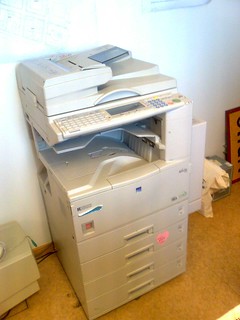Although Copy Machines seem harmless they alone can leek personal information and cause serious trouble. John Juntunen of Digital Copier Security said: “Nearly every copier built since 2002 contains one of these, a hard drive.” Exactly like the hard drive in a computer the hard drive in a copier, saves everything whether it was copied, emailed, or scanned. That means all medical documents, birth certificates or other important/personal documents are stored in your copy machine’s memory and if found in the wrong hands can cause you serious troubles.
How to Defend Your Information
Copiers along with MFDs (Multi-Function Device [such as a device that is a fax machine, photocopier and printer all in one]) store data. Most copiers and MFDs are often found in business settings along with public locations while also being available for the house.
If you have a personal copier there are two real dangers of having your information stolen: 1. Disposing of your copier or MFD without removing or wiping its hard drive. 2. Someone gaining access to your wifi network and to your copier/MFD. If your copier/MFD is old or broken and you are considering throwing it away or selling ALWAYS REMOVE/WIPE THE HARD DRIVE there could potentially be important and private information stored on it. If you need your copier’s/MFD’s hard drive wiped bring it in to South City Computer and we will do it for you! The second one can only happen if your copier/MFD is connected to your network because it is wireless. To ensure no one gaining access to your network, set up a secure password (if not having one already).
If you are going to use a public photocopier, be very cautious about what you are going to copy. There is no telling whether the photocopier deletes all the information stored on it so always be cautious if the information you are photocopying could or could not be harmful information if it was accessible by others.
If you are using a copier at a business not only should the concern of disposing of your copier without wiping the hard drive and via the network but also have a concern of who has actual contact with the copier, for example: coworkers, customers, etc. Although seeming unlikely just by removing the hard drive and using a free software program to scan the hard drive, could download all the files off of it. If your copier is used often throughout your work there could be essential business information leaked if your copy machine’s hard drive is left unprotected.
Click here to view the video by CBS.
If you or your business ever need a copier or MFD hard drive erased, call us at: 314-400-7918


 With Microsoft’s release of Windows 8 there have been a lot of questions and complaints concerning the most bold new feature, the Start Menu. The Start Menu which replaces the desktop at the start of your computer is considered “innovative” and “incredible” but also is giving users a hard time. We here at South City Computer made a guide for those who are struggling with this new feature, so to help you navigate it better.
With Microsoft’s release of Windows 8 there have been a lot of questions and complaints concerning the most bold new feature, the Start Menu. The Start Menu which replaces the desktop at the start of your computer is considered “innovative” and “incredible” but also is giving users a hard time. We here at South City Computer made a guide for those who are struggling with this new feature, so to help you navigate it better. Usually for customers bigger businesses means better, for example big business clothing stores may be more cost effective than local clothing stores. This idea of “bigger is better” may be true in various retail stores but in the field of computers it is actually quite the opposite. With some big businesses that offer computer repair services, like Best Buy, why shop local?
Usually for customers bigger businesses means better, for example big business clothing stores may be more cost effective than local clothing stores. This idea of “bigger is better” may be true in various retail stores but in the field of computers it is actually quite the opposite. With some big businesses that offer computer repair services, like Best Buy, why shop local? Did you know that data loss has become increasingly more common since 2008? The Open Security Foundation has recorded the increase of data loss incidents since 2008, claiming that it has become a major problem for some businesses.
Did you know that data loss has become increasingly more common since 2008? The Open Security Foundation has recorded the increase of data loss incidents since 2008, claiming that it has become a major problem for some businesses. In HDD’s ,or hard disk drives, spinning platters hold your data saved on it. When data ,such as a photo or a word document, is first written on the drive it is in order on the platter making access to it speedy. A hard drive becomes fragmented when the file gets spread apart on the drive losing it’s order and quick access. Fragmentation when your data on your hard drive constantly change, let’s say you save files A,B, and C, you then deleted B and save file D then file D takes as much of the space it can where file B was but that space didn’t have enough room(files D is much bigger then B). Now this file D is cut up with file C in between it. That is fragmentation
In HDD’s ,or hard disk drives, spinning platters hold your data saved on it. When data ,such as a photo or a word document, is first written on the drive it is in order on the platter making access to it speedy. A hard drive becomes fragmented when the file gets spread apart on the drive losing it’s order and quick access. Fragmentation when your data on your hard drive constantly change, let’s say you save files A,B, and C, you then deleted B and save file D then file D takes as much of the space it can where file B was but that space didn’t have enough room(files D is much bigger then B). Now this file D is cut up with file C in between it. That is fragmentation In 2001, Microsoft release what some might argue was their greatest operating system of all time: Windows XP. Windows XP brought in great advances over it’s predecessor, Windows 2000. It brought Windows away from just home desktop computers, and extended it to laptops, and even servers. Then in 2006, Microsoft released what some might argue was their worst operating system of all time: Windows Vista. The tremendous failure that this system was among consumers gave new life to Windows XP, extending the long-term support period all the way into 2014. This makes XP the longest supported OS Microsoft has ever released.
In 2001, Microsoft release what some might argue was their greatest operating system of all time: Windows XP. Windows XP brought in great advances over it’s predecessor, Windows 2000. It brought Windows away from just home desktop computers, and extended it to laptops, and even servers. Then in 2006, Microsoft released what some might argue was their worst operating system of all time: Windows Vista. The tremendous failure that this system was among consumers gave new life to Windows XP, extending the long-term support period all the way into 2014. This makes XP the longest supported OS Microsoft has ever released. As many social networks are now becoming something like an archive of your life. You can scroll down, and down, and down, all the way back to the day you created your account. Snapchat’s main feature is that it does the exact opposite of this, your photo messages to others stay for only a set amount of time, with a maximum of 10 seconds. What about your information though? You may not remember when you signed up, but you were asked for your phone number. The purpose of this is so that your account can be linked to your mobile device, making it easier for others to find you. But this information doesn’t disappear after 10 seconds, it stays around forever. And this, of course, means that it can be hacked.
As many social networks are now becoming something like an archive of your life. You can scroll down, and down, and down, all the way back to the day you created your account. Snapchat’s main feature is that it does the exact opposite of this, your photo messages to others stay for only a set amount of time, with a maximum of 10 seconds. What about your information though? You may not remember when you signed up, but you were asked for your phone number. The purpose of this is so that your account can be linked to your mobile device, making it easier for others to find you. But this information doesn’t disappear after 10 seconds, it stays around forever. And this, of course, means that it can be hacked. In the beginning of 2014 Yahoo’s ads contained malicious software (malware) which infected an estimated 2 million users computers. It was estimated that almost 27,000 computers using Yahoo were infected an hour. The computers that were infected through Yahoo, were using up a massive chunk of the computers resources as bit coin slaves, where without the users knowledge the computers were mining bit coins thus harboring a lot of the computers capability. Although malware today is very common especially through email and the Internet; there are still ways to defend your computer.
In the beginning of 2014 Yahoo’s ads contained malicious software (malware) which infected an estimated 2 million users computers. It was estimated that almost 27,000 computers using Yahoo were infected an hour. The computers that were infected through Yahoo, were using up a massive chunk of the computers resources as bit coin slaves, where without the users knowledge the computers were mining bit coins thus harboring a lot of the computers capability. Although malware today is very common especially through email and the Internet; there are still ways to defend your computer. If you think your Xbox One might be backwards compatible with an Xbox360 or if you’ve seen any posts online about how to play Xbox 360 games on your Xbox One then you’d better think again.
If you think your Xbox One might be backwards compatible with an Xbox360 or if you’ve seen any posts online about how to play Xbox 360 games on your Xbox One then you’d better think again.